October 2018 – While the most famous and beloved part of the RV/MH Hall of Fame and Museum in Elkhart, Indiana, is the fabulous display of antique trailers and motorhomes downstairs, the library upstairs is an equally outstanding (if less flashy) gem.

The RV/MH Hall of Fame and Museum antique trailer display downstairs is fabulous.
But you’ve gotta check out the library upstairs too!
Every year notable people in the RV and Manufactured Housing industries are inducted into the Hall of Fame, and when you head upstairs in the museum you can find walls filled with plaques commemorating the work of each inductee.
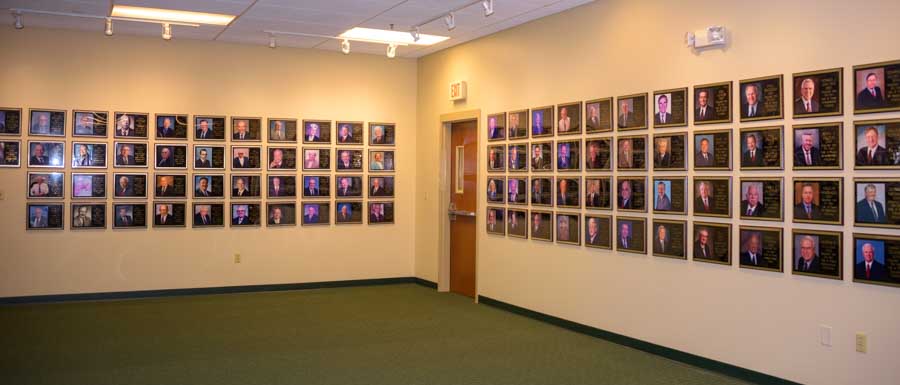
The “Hall of Fame” dignitaries in the RV and Manufactured Home industries.
Around the bend there is a library that is open to all visitors. This sizeable room is filled with several rows of bookshelves that house all the periodicals and publications in the RV and Manufactured Housing industries since its inception.
There’s bit of whimsy in this library: the tops of the bookshelves are decorated with toy RVs!

The library upstairs is a wonderful place to kick back and learn a little history.
I find the history of RVing very interesting because it is a hobby and a lifestyle that has rolled through our nation’s history for over a century, a time that has included two world wars, economic booms and depressions, baby booms and boomlets, energy crises and more.
As a columnist for and avid reader of Trailer Life Magazine, I was especially eager to look at some of the earliest editions of its predecessor publication, Trailer Travel Magazine.
High up on a bookshelf I found a row of the earliest Trailer Travel magazines the museum owns, all nicely bound by year.

Bound volumes of Trailer Travel Magazine from the 1930s to the 1960s
I randomly took one volume down and flipped it open to the January 1959 issue. The little girl in diapers could have been an older sister of mine or a younger sister of Mark’s. How fun!
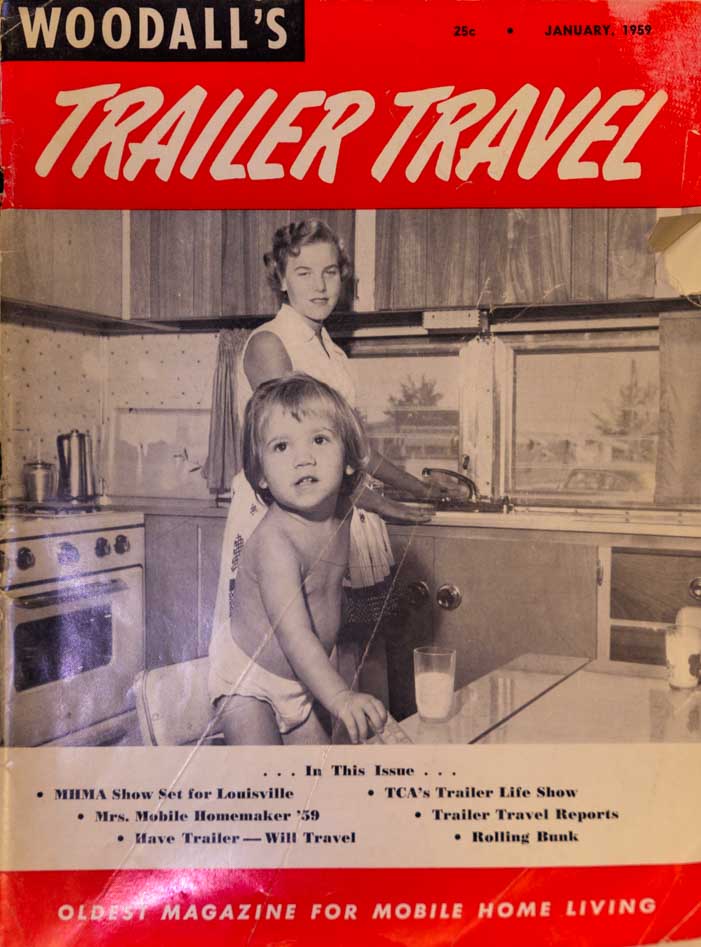
Trailer Travel Magazine – January 1959 – 25 cents an issue
Flipping the magazine open to a random page, I found a fantastic two page advertisement for Airstream trailers called “Land Yachting.” The accompanying photo showed a motor yacht tied up at a dock where an Airstream was parked. Very cool!
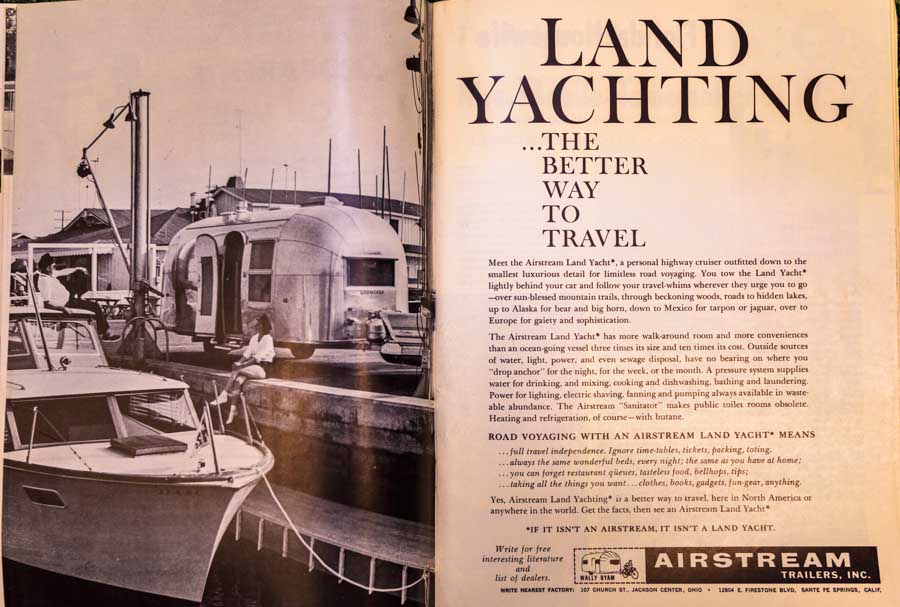
Awesome!
Thumbing through a little more, I found an article about a fellow who loved the trailer lifestyle so much he had built a custom home that he could back his trailer into. While the house had a full kitchen, living room, bedrooms and bathrooms, he could also use all of the trailers amenities when it was parked inside the house!
This fellow had been involved in the RV industry for a long time, towing trailers since 1924, and he confessed that he and his wife preferred the bedroom in the trailer to any of the bedrooms in the house!

This guy liked to back his trailer right into his custom home and use it inside the house!
I picked up the volume for the 1937 issues of Trailer Travel (the magazine started in 1935 but I didn’t see that volume there).
The January 1937 issue cost just 15 cents and it featured a photo of a palm tree lined street on the cover and the promise of an article about “Trailing Through the Land of Thrills” inside.
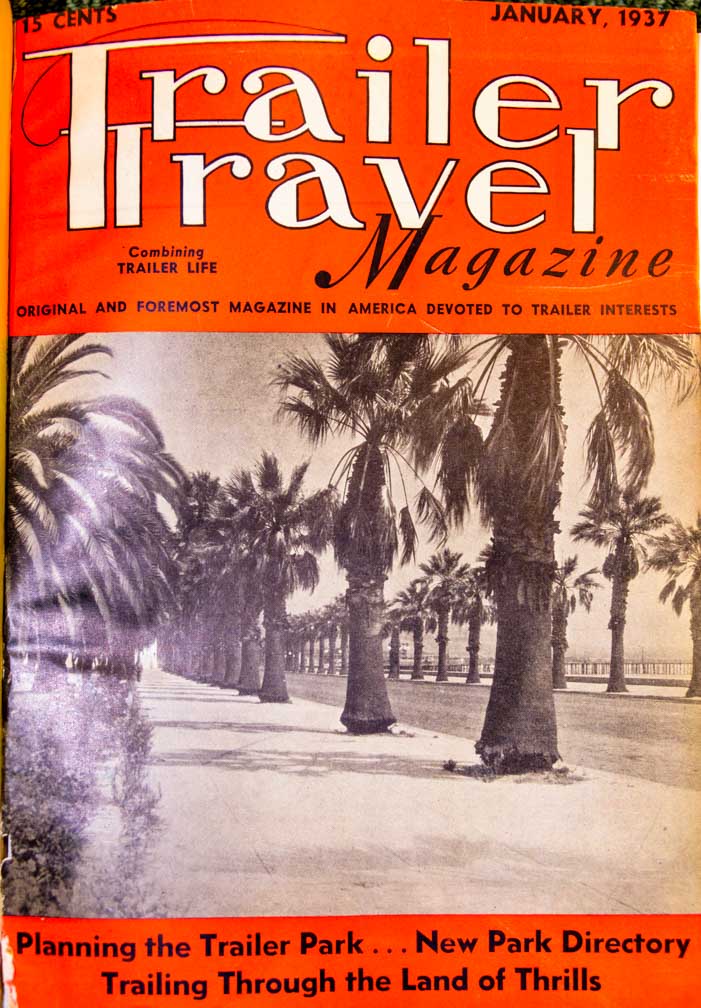
Trailer Travel Magazine – January 1937 – 15 cents an issue
Like today’s Trailer Life, the magazine was filled with advertisements. Of course, as with any media publication, including this website, the ads make it possible to pay the bills. But I loved each and every one of the ads because they said so much about the life and times and interest and concerns of the RV industry back in 1937.
We had seen several Covered Wagon trailers in the museum downstairs, and here was an ad for the 1937 model. By the looks of the lady in her evening gown, this was a trailer for the well-to-do. Boasting “superb perfection of design” and “eight years of quality trailer building,” this rolling home would set you back $1,295.

At $1,295, this trailer must have been quite a luxury during the Great Depression.
In 1937 America was still deep in the throes of the Great Depression, and $1,295 was an exorbitant amount of money. No wonder the lady was in such an elegant gown as she prepared for a night on the town. She was a woman of means who had somehow escaped the worst of the economic woes that the Great Depression wrought.

The Silver Dome had a caster type wheel under the hitch pin.
It struck me that owning a trailer was not something that was probably possible for most families, as many families didn’t have a car in 1937. “Trailerites,” as the early RVers were called, must have been a fairly exclusive crowd, especially when the country was in the grip of the Great Depression.
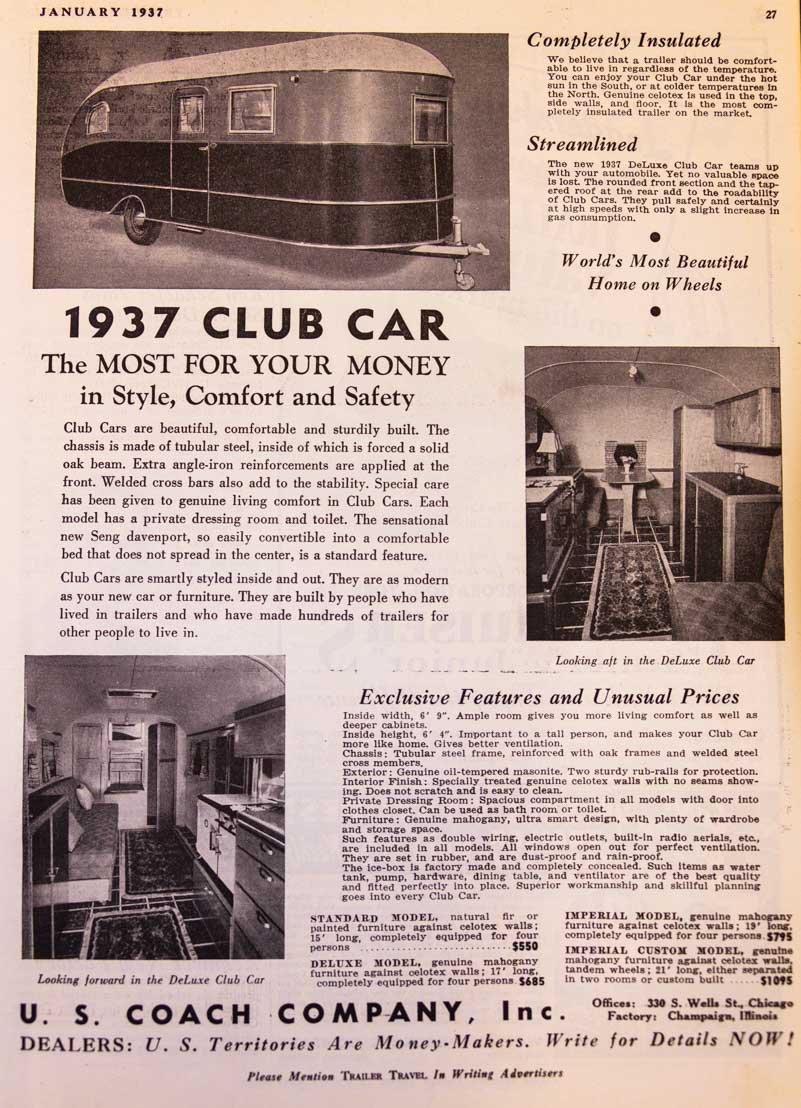
.

.
But there were trailer builders out there who were aiming at a more budget oriented crowd. The 17′ Indian “Scout” started at a mere $395, just 1/3 of the cost of that fancy 22′ Covered Wagon model.

A smaller, simpler trailer for just $395.
Another big surprise was that many of the trailers in 1937 (model year 1938) offered most of the household comforts we have built into our trailers today, from water tanks to kitchen stoves to insulation and more.
One ad for the Bender Travel Mansion boasted air conditioning and heat which they said marked “a new era in trailer life!”
Not only did the 1937 Bender Travel Mansion feature climate control, it also had a hot and cold water shower, a flush toilet and an automatic electric and marine water system. The foundation was the Bender Tandem Axle and Spring suspension system, and the interior was walnut.
All this for a base price of just $447.

Air conditioning, heat, hot and cold shower and flush toilet — in 1937!
I was also surprised that most trailer ads stressed that their units were all steel construction. This didn’t mean just the frame, as it does today. The studs and rafters were welded steel too.
When we had looked at the units in the museum downstairs, Mark had noted that even the aluminum sided models of the early years had tack welds rather than rivets.
These early trailers were solidly built and heavy!

These trailers were super rugged and all steel.
The 1938 Hayes trailer featured not only a complete steel cage — chassis, frame, sides, roof were all “electric welded into one rigid piece” — but it also had five kinds of insulating materials.
One insulating material mentioned was “Reflect-O-Cel aluminum air cell insulation” used in the roof.
This sounded a lot like our modern product Reflectix that many RVers use to block heat and cold in their RV windows. It also sounded a little like the “radiant barrier” that trailer manufacturers use today (although some radiant barriers we saw on factory tours resembled aluminum foil while others were a foil product that had some kind padding).

A steel cage frame and 5 materials for insulation including “Reflect-O-Cel.”
I was intrigued that while today there are many industry publications for people who work in the RV industry and a few magazines geared towards consumers who buy RVs, the early Trailer Travel magazine had a very wide audience that included not only the manufacturers but the “trailerites” who bought them, the campground and trailer park owners who were hosting them and the dealerships who were selling the manufacturers’ products.
So, there were ads for everything from Coleman stoves to trailer windows, a new folding trailer step, Foreman trailer axles, Bendix power brakes and a Red Top Gas-O-Lectric AC/DC Power Plant to give the trailer electricity when it was parked off the grid.

1937 Coleman stoves.

Trailer windows… not very different from today.
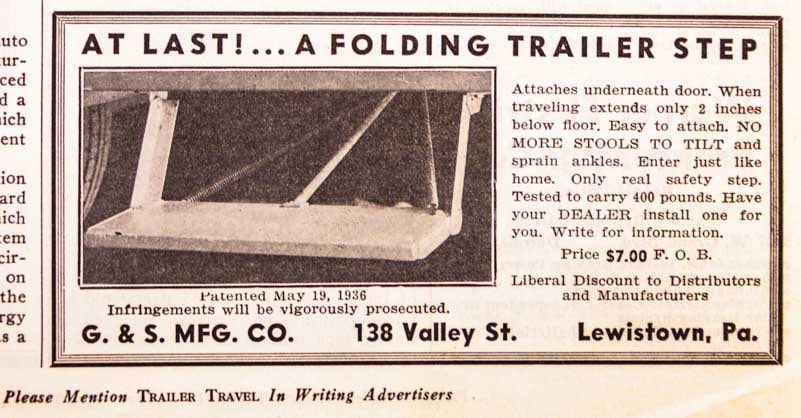
A fold-out step!

Trailer axles.

Bendix Power Brakes save your car’s brakes…same thing today!

AC and DC power for the trailer when it’s not plugged in.
I was also fascinated to see that companies had emerged to rent out trailers to folks on vacation. Western Trailways Service offered trailers for $5 a day for one or two people or $6.50 for three or four people. Why spend $400 or more buying a trailer when you could rent one for a weeklong honeymoon for just $35?
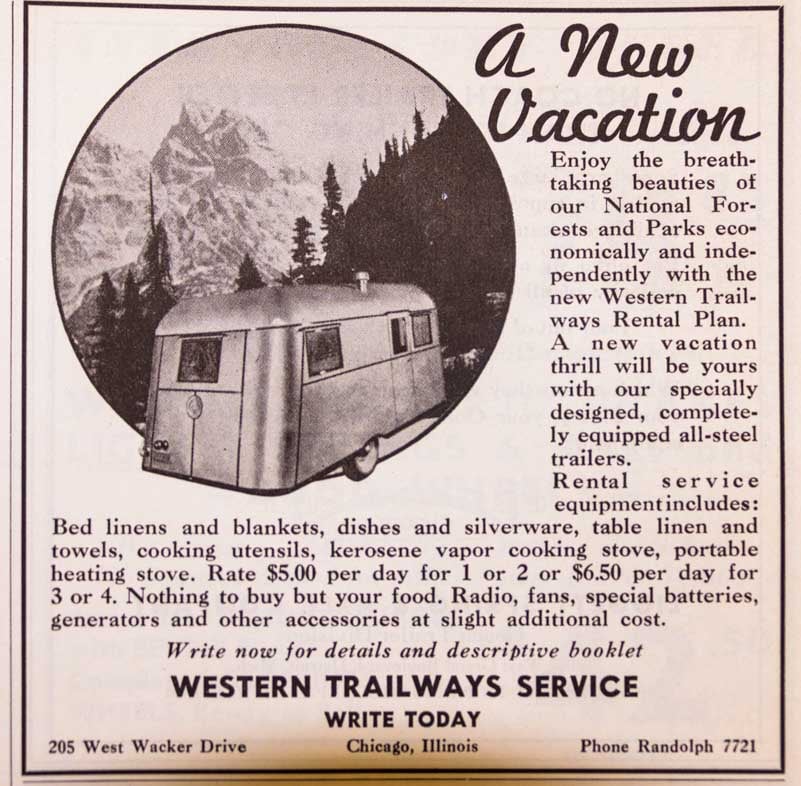
Why not rent a trailer for a week before going all in and buying one?
Just as fascinating, or perhaps even more so, was reading the articles about where people took their trailers in 1937. An ad for Covered Wagon explaining their sales method of selling a base model plus options showed a young couple dressed up for camping in nature.
It was a different era!

Camping in style.
One photo showed several riders on horseback and a trailer parked on the side of a dirt road, a glimpse of the transition still taking place in the 1930s in the most rural areas from horse to motorized travel.
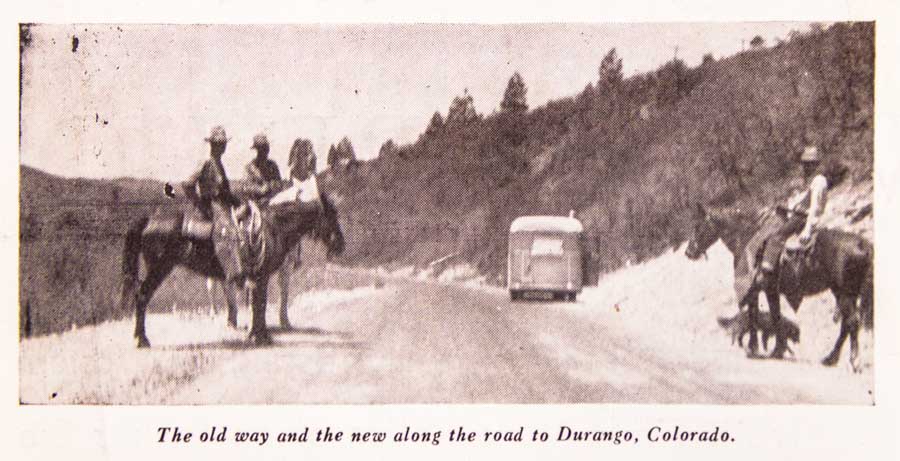
Old and new modes of transportation on the dirt road to Durango Colorado
An article entitled, “Yellowstone Parking – A Trailer Travel Thrill!” described a trailer trip to Yellowstone National Park.
Some things have changed quite a bit since 1937. A photo showed a black bear eyeing up a car towing a trailer. In those days feeding the bears was a popular activity at Yellowstone. Fortunately, from what I understand, grizzlies were extremely rare in the Park back then since they were not a protected species.

It was common practice to feed the bears at Yellowstone back in 1937
But the fishing on Fire Hole River (“Fire Hole” was two words in those days) seems like it was much the same, excellent both then and now.

Fire Hole River in Yellowstone.
And photography was as important to Yellowstone visitors in 1937 as it is to all of us today.
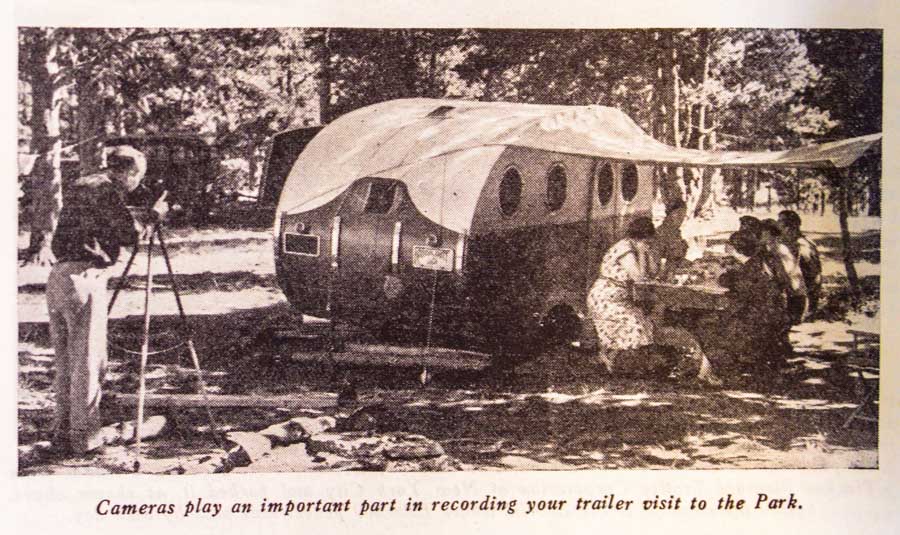
A “trailerite” family enjoys a meal together in their campsite while dad snaps a pic.
As I perused the January 1937 issue, I discovered that the feature article, “Trailing Through the Land of Thrills,” was all about taking your trailer on a fabulous adventure down to Mexico City.
The new 1,000 mile long international highway had been completed in July, 1936, and Americans were taking their cars and trailers down the highway and loving it.
Interestingly, that was not the only travel destination feature article about going to Mexico in 1937. In the August issue of Trailer Travel Magazine there was an article about taking your trailer down to the fabulous tropical destination of Acapulco!
Mark and I spent some time in Acapulco on our sailboat, and although Acapulco is sadly very dangerous in many areas today, it was easy to see how extraordinarily charming it must have been years ago.
When we anchored there we heard whales singing in the water around our hull at night, and we saw a seahorse attached to our anchor chain when we hauled the anchor up. The water just outside the populated area was the bluest blue we’d ever seen, and at night Acapulco Bay looked like a bowl full of diamonds as all the homes on the steep hills around the bay lit up.
I can only imagine how exotic it would have been to take a trailer down to Acapulco for a tropical winter vacation in 1937.

Acapulco’s town beach
Another fascinating article was entitled, “What is Happening to the Trailer Industry?”
Apparently for the first half of 1937 trailers flew off the shelves, so the manufacturers ratcheted production up to high gear. By May, however, trailers had stopped moving and there were surpluses everywhere.
The article pondered whether the sudden slowdown was because President Roosevelt had tampered with the Supreme Court as he tried to push through his New Deal legislation. Or perhaps the Housing Act of 1937 (Wagner Act) which provided government funding for public housing agencies to assist low income families was the cultprit.
The writer also mused that the problem might be plain old competition. He noted that for every one trailer being built by a manufacturer in 1937, four were being built at home. I guess in 1937 “trailerites” were looking for affordable trailers that were customized to their own needs and preferences.
Boy, does that sound familiar!
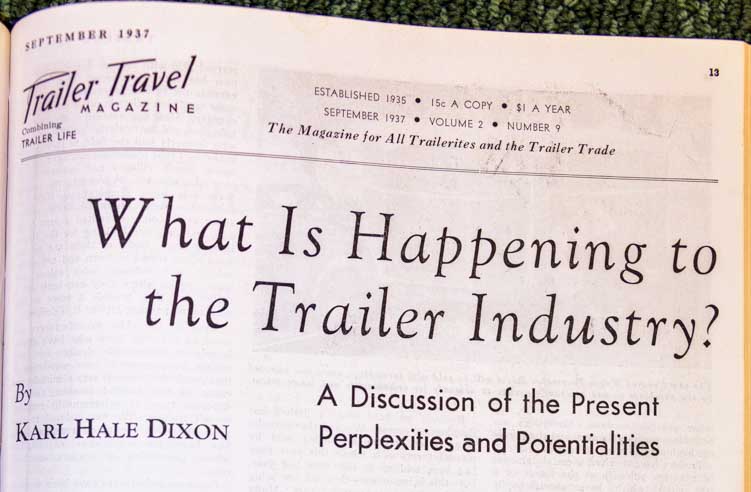
The RV industry has always been cyclical,
but even so, a sudden downturn in 1937 prompted some soul searching.
On the positive side, another article in the January 1937 issue discussed how Hollywood was becoming more and more enamored of using trailers on movie sets.
Downstairs in the museum of antique trailers we’d seen a fabulous House Car on display that belonged to Mae West. However, it wasn’t until the 1930s that the stars in Hollywood routinely began to use luxury trailers as mobile dressing rooms and places to relax on set.
One article entitled “Trailer Trails to Health: Water” discussed the importance of finding good drinking water in your travels. The article opened with a cute reference to Samuel Coleridge’s poem in which the Ancient Mariner lamented, “Water, water everywhere and not a drop to drink.”
Today we all rely on bottled water that is in abundant supply everywhere, but in 1937 the only choices were city water, which was filtered, chlorinated if necessary, and approved by the State Department of Health, and well water or spring water which was a gamble.
“Trailerites” were advised to seek out city water supplies and to use spring or well water only if it had a certificate on it from the State Board of Health.

Finding safe drinking water was a big concern for “trailerites” in 1937
I grabbed the Trailer Travel volume for 1940 and flipped through a few issues.
The price of the magazine had dropped from 15 cents in 1937 to 10 cents in 1940, and it was now called Automobile & Trailer Travel Magazine.
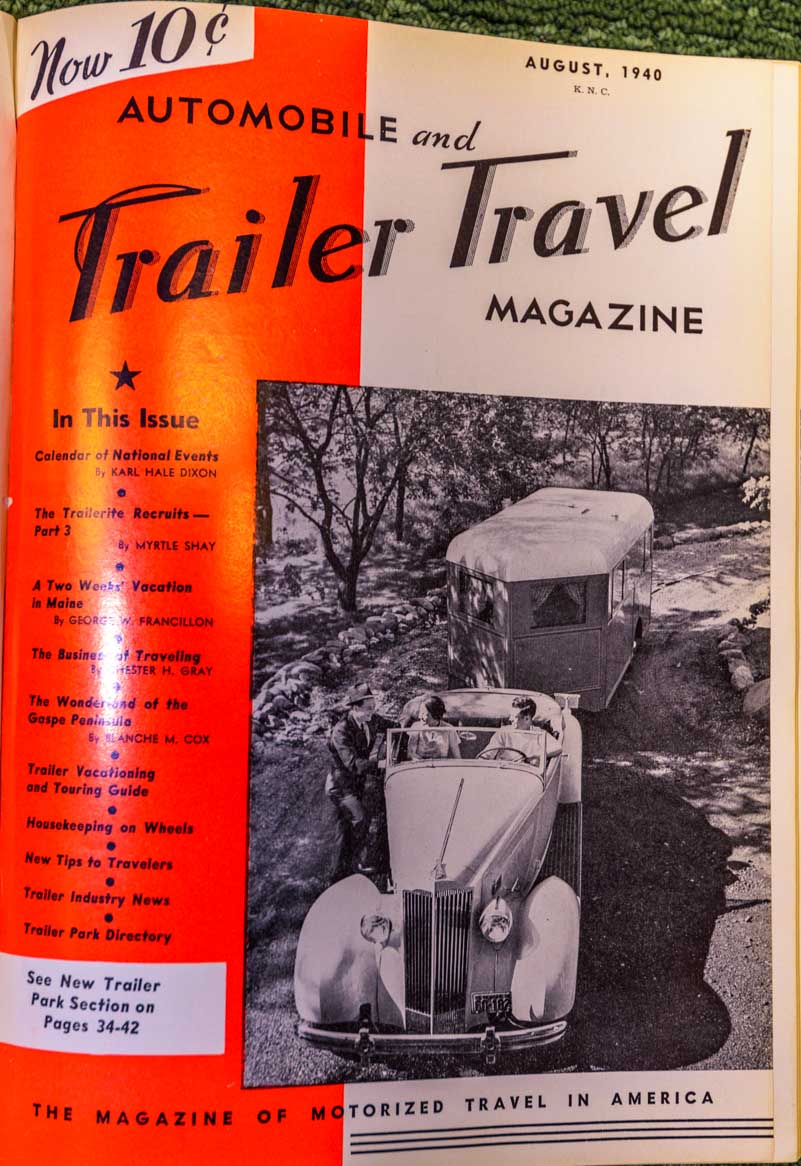
Automobile & Trailer Travel Magazine – August 1940 – Now 10 cents an issue!
What a neat surprise it was when I saw an ad for a 4.8 cubic foot electric refrigerator!
This RV fridge was a combination electric refrigerator and ice box. When you took your trailer off grid, rather than relying on propane, which came later, you could pack 50 lbs. of ice in the ice box and still enjoy a cold beer.
In 1940 there were still rural folks who didn’t have running water or electricity, but the finest trailers had electric refrigeration!

A 4.8 cubic foot electric fridge with a big ice box for off-grid camping.
The October 1940 issue featured an article, “How To Use Your Camera,” that explained how to take advantage of different film speeds. Of course, film cameras have gone the way of the ice box!

Photography and travel have always gone hand-in-hand, whether the camera is film or digital.
I jumped ahead a few shelves and pulled out the March 1977 issue. The magazine was now called Woodall’s Trailer & RV Travel, and the cover showed a pop-top van as one of the best new designs of the year.
Water was still covered in this issue in 1977, but the focus in this particular article was on how the RV’s water system works and what to do when it doesn’t.
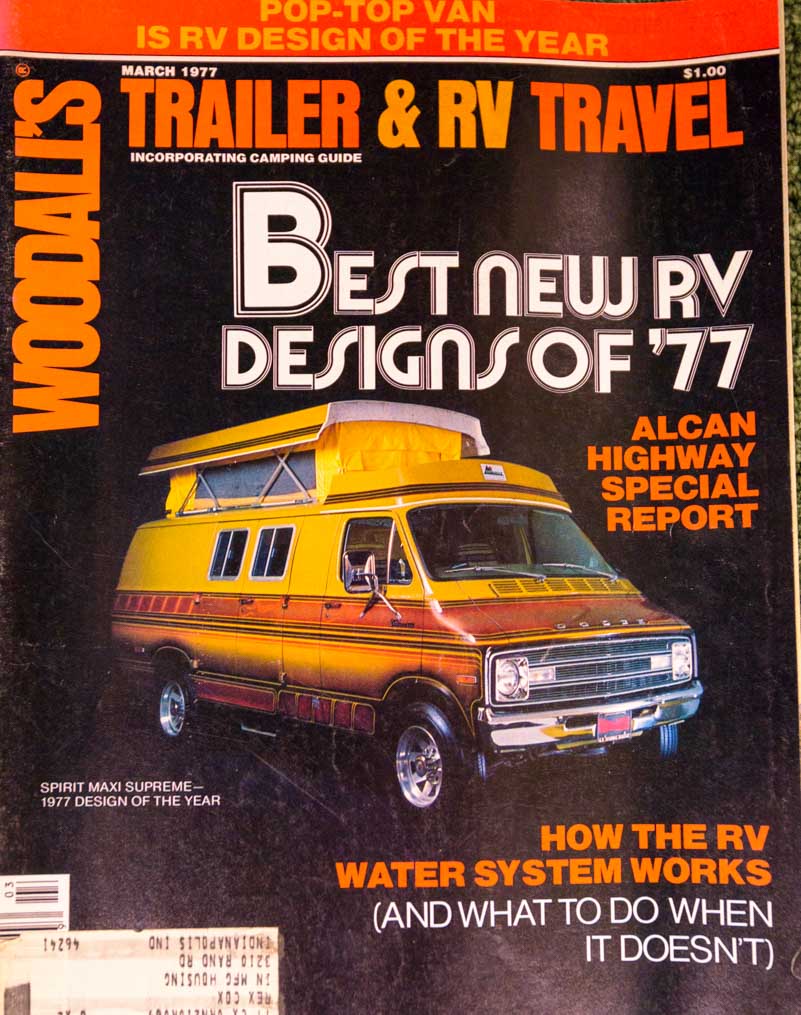
Woodall’s Trailer & RV Travel – March 1977
My jaw just about hit the floor, however, when I opened another issue from 1977 and discovered that finding safe drinking water was just as big a concern in 1977 as it had been 40 years prior in 1937.
Not only did the article, “The Traveler’s Guide to Water,” warn RVers not to trust random wells and springs for drinking water, but it also opened with the same quote from Coleridge’s poem The Ancient Mariner: “Water, water everywhere and not a drop to drink.”
How funny.
Ironically, when I wrote an article for Cruising World Magazine a few years ago about our sailboat’s water desalination system that converted ocean water to drinking water, the editors titled it, “Water, water everywhere…”
Coleridge’s Ancient Mariner is timeless!
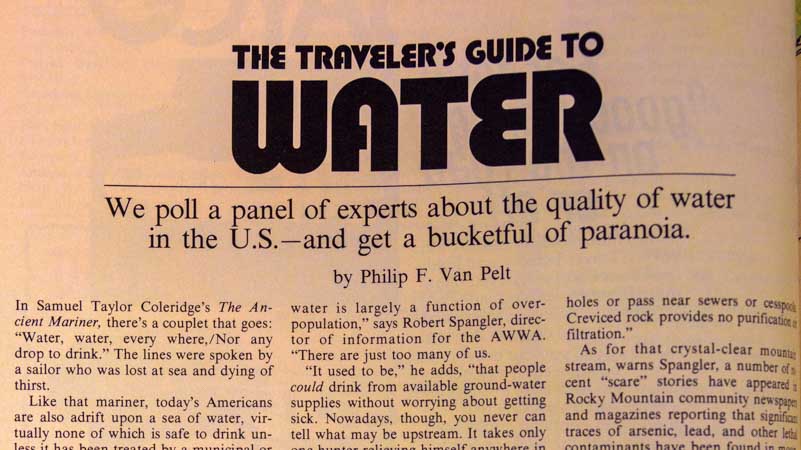
Finding safe drinking water was still a big concern in 1977, some 40 years later!
In 1977 there was also a lot of concern about the safety of taking an RV into Mexico. Several articles discussed rising crime in Mexico, but the writers expressed hope that it was a temporary problem that might abate in the near future.

Camping on the beach in Mexico!
When we were in Puerto Vallarta, Mexico, on our sailboat, we were very fortunate to meet a young German man who had been raised in a Class C motorhome by his adventurous parents as they traveled all over North America. While showing us his photo albums of family photos, he described camping on the beach in Mexico as a kid in the 1980s. How fun!
At one point, his dad had gotten the clever idea to ask a train conductor heading through Copper Canyon if they could put their motorhome on one of the empty flatbed train cars. Soon, a whole generation of adventurous RVers were riding flatbed cars on that train and enjoying a trip of a lifetime.
Blog posts about meeting this special fellow here and here.
Another big topic of concern in Woodall’s Trailer & RV Travel in the late 1970’s was the future of the Alaskan wilderness. The public land debate goes back over a century and is very complex, but the Alaska Pipeline spawned much debate in the late 1970s, and Woodall’s Trailer and RV Travel weighed in with their thoughts.

Public land debates were as hot in 1977 as they are today.

Interesting to look back on this comment 40 years later.
By the 1970s, Woodall’s Trailer and RV Travel Magazine was published solely for RVers — the consumer side of the RV industry — and was no longer a trade magazine for the RV industry itself. But one amusing business-oriented article headline caught my eye: “Renting Your RV – It Could Put 10 Grand in your pocket.”
There has been an effort in recent years to put potential RV renters together with people who’d like to make a little side income from renting out there RV. I had no idea that this business model dated back 40 years, but there it was in 1977!!
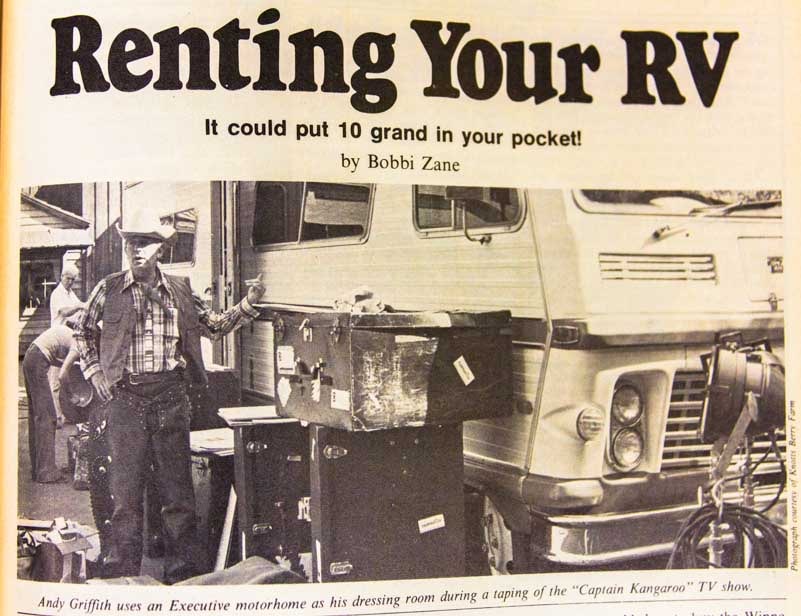
Renting your RV is not a new concept. Heck, folks were putting 10 grand in their pockets doing it in 1977!
I had a hard time leaving the RV/MH Hall of Fame Library and could easily have stayed a few more hours. But the volunteer at the front desk downstairs came up to me at closing time and told me very kindly that she was going to shut off the lights in a few minutes!
She let me hunt down one last magazine from August 2010, an issue of Good Sam Club’s Highways Magazine. The cover of this magazine featured our little buggy in a streamside setting. She smiled as I snapped a photo of the cover and told her that the very same trailer was parked out in their parking lot right now.
Looking at the Highways Magazine cover more closely a little later, I noticed that besides my article about Idaho’s Sawtooth Mountains, there were articles on water filtration and brakes and there was even a photo contest.
So many themes in RVing have stayed the same, all the way from 1937 to now.

Water, brakes and photography were all in this issue too!
If you have a chance to visit the RV/MH Hall of Fame and Museum, allow a little extra time to sit in one of the comfy chairs upstairs in the library and thumb through a few RVing magazines of yesteryear. It is a heartwarming journey.
You can subscribe to the modern day Trailer Life Magazine here and see our photos and stories in its pages almost every month!

More info about the RV/MH Hall of Fame Museum and Library:
- RV/MH Hall of Fame Museum
- RV Parks and Campgrounds near Elkhart
- Location of the RV/MH Hall of Fame Museum Library
Subscribe
Never miss a post — it’s free!
Other blog posts from Indiana and the RV/MH Hall of Fame Museum:
- RV/MH Hall of Fame + Elkhart (RV Heart) Indiana
- Elkhart, IN – A Visit to the RV/MH Hall of Fame
- Elkhart, IN – RV Factories and Amish Country
Our most recent posts:
- Quick Release Pull Pins for Fifth Wheel Landing Jacks – YES! 05/03/24
- Sheep May Safely Graze (in the Mountains with Dogs!) 04/26/24
- How to Replace Electric Fifth Wheel Landing Legs – Easy DIY! 04/19/24
- Lost Dutchman State Park: GORGEOUS scenery & RV campground! 04/12/24
- CargoBuckle Retractable Ratchet Tie-Downs – SO EASY! 04/03/24
More of our Latest Posts are in the MENU.
New to this site?
Visit RVers Start Here to find where we keep all the good stuff. Also check out our COOL NEW GEAR STORE!! *** CLICK HERE *** to see it!
<-Previous || Next->

Great article
Thanks, Steve!
Wow, you have really outdone yourself with this post! The museum is fabulous, but I suspect very few visitors ever check out the library. Thanks.
Thank you, Bruce. It was a lot of work to put this together, but I was so intrigued by it all that I wanted to be sure our readers — including those who have been to the museum — knew about the treasures that lie upstairs!
Wow, it’s fun to see how it was – the guy in the tie all dressed up cracks me up. Don’t see that in the campground today!
That’s for sure, Steve. I wonder how it would be to hike in a dress and pumps! I suspect that in the early days the upscale trailer manufacturers were suggesting with their ads that trailers could take you to the country’s most chic spots in style…!
Em,
Love all these old mags, ads, and pictures of time gone by. Almost like being in a time machine. 😉
“A Discussion of the Present Perplexities and Potentialities?” Quite a subtitle…
Bob
Me too, Bob! In the olden days of not so long ago, magazines published longer articles and writers were more elaborate in their choice of words and phrasing. That elaborate subtitle really does say it all about the subject matter the writer was tackling, but I’m not sure editors today would go for it.
Really fascinating article. Well done!
Thank you! It took many hours, so I’m thrilled you and others are enjoying it.
What a wonderful article and walk back in time. I love to see how the RV “pioneers” started. Must just be from the same stock that settled the West but with newer wheels!
So great that they allowed you to peruse these articles. Thank you for taking the extraordinary amount of time scanning, photographing and then writing such a wonderful piece!! Buddy must’ve been beyond ready for a latte.
Buddy was very excited when I finally came out of the library. He likes the taste of old magazines we’re discarding but isn’t much of a reader!
The library is open to everyone, and every periodical you can think of related to RVing is there, some bound in volumes and others just loosely boxed. The whole idea behind the library is to allow people to do whatever research they want to into the origins and history of the RV and Manufactured Housing industries.
I would have loved to have been around when those old trailers first hit the road. You can feel the excitement in those early days of the industry when the manufacturers were trying all kinds of new things and the possibilities for the “trailerite” lifestyle seemed endless.
I thought I recognized the front page photo on the cover of the Highway Magazine cover…Isn’t that your rig? Your photo?
On the cover….Great article, very interesting.
Yes that is our rig and our photo on the cover of Highways, Rick. It was one of our earliest cover photos, back in August 2010!
What a fun read! My parents and grandparents were one of the people who enjoyed the Mexican Train Ride with their RV. My siblings and I were too young to go so we stayed at a friend’s home during their trip. So much has changed, yet so much has stayed the same. What a great way to see America. If I ever make it to the museum, I will stop into the library and enjoy a seat 🙂
Also, I noticed a typo – the ‘R’ is left out in your first mention of the Ancient Mariner.
We have friends who did the Mexican Train Ride with their fifth wheel, and they count it as one of the best travel experiences of their lives. I sure wish it were still offered, but unfortunately that area is now a hotbed for the cartels. Definitely check out the library when you get to Elkhart. It is a wonderful eye opener into the past, especially for those of us who weren’t alive in those days. Thanks for your eagle eyes; he is no longer the Ancient Marine!
Thank you for all of that information – I loved it!! It’s like a thesis on RV & travel history!! Very interesting stories – I like the guy who parked the travel trailer in his house!! lol…. 🙂
Me too, Deborah! Can you imagine pulling your trailer right into your house??!! That shows the kind of enthusiasm people had for these things in the early days. They were so novel and so exciting for them…
Wow, Emily, this is a wonderful post! I noticed that very few of the ads had telephone numbers (“write or wire” seemed to be the popular options back then) and, since most of the ads indicated that shipping was “F.O.B.” the manufacturers’ locations, I wondered how much buyers generally would have had to pay for freight or shipping. Very, very interesting!
Alan and I stopped at the Hall of Fame when we were heading back home from a cross-country trip for personal business in 2017. We hit Elkhart late in the day and arrived about a half hour before the Hall of Fame closed. We really enjoyed the display of antique and vintage RVs and admired the creativity of the crew that designed and implemented the display. Like you, we closed the place down, but we never realized that a gorgeous library existed upstairs. We wouldn’t have had time to check it out that day (and our scheduled wouldn’t have allowed a layover even if we knew it was there), so it looks like another stop in Elkhart is in our future. Thanks for all of the time and effort you put into this post – it made for a very enjoyable read!
Thank YOU, Mary, for appreciating this post. I noticed that there were few phone numbers too, but I doubt all that many people had telephones in 1937. So, mail and patience was the way to go! As a writer yourself, you will love the library when you see it on your next trip to Elkhart. Enjoy, and allow a few hours to relax with these precious bits of history!
Oh ! the nostalgia for the America of yester-year, written with such affection ! Thanks for giving RLT readers this precious journey back in trailer-time !!!
It is so touching to look back. You and others of our readers remember those days but we can only imagine them and wonder…
Great article. I only have to wonder about the weight of steel shrouded 1937 trailers and the towing capacities of cars in those days. How much attention was put into that aspect of towing! Looking at the sophistication of those trailers, I assume they spent time looking at the towing aspect of it also.
As you say, those all-steel trailers must have been heavy, Dick, and those folks weren’t towing them with high towing capacity trucks either. I imagine there was a lot of experimentation in the early days and plenty of overloaded cars struggling to tow their loads too. I’m sure that’s what gave rise to the knowledge we have today and the requirement for specs that manufacturers provide on all vehicles about what they weigh, what they can carry and what they can tow.
Wow! RV Industry…..what ever happened to the craftsmanship, integrity, honesty, and personalization that once existed in your industry. Very sad! Profits rule! The hell with everything else! Salute to the good ole days!